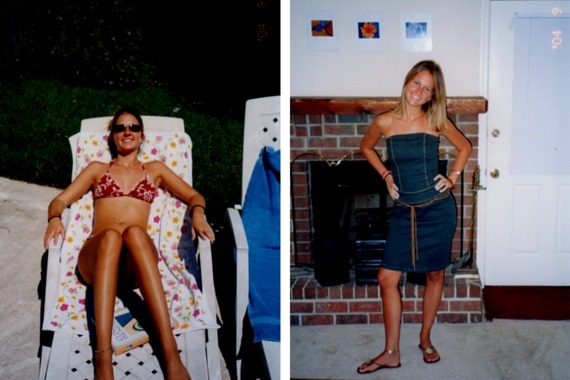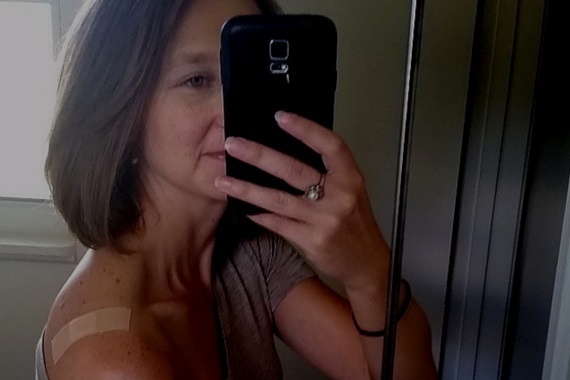
I remember the day so vividly. It was the summer after my junior year of college and I was working at a summer camp in Michigan.
I called my parents in Florida just to say "Hi" and let them know how camp was going, when my mom got very serious and said, "We got the biopsy results back from the Dermatologist. You have Melanoma."
I was in complete shock. Who gets skin cancer at 19 years old?!
Flashback to Pre-Diagnosis
The week before leaving for camp that summer, I was in the kitchen getting a snack, wearing my colorful striped bikini (which I practically lived in), and my mom pointed out that I had a large dark mole on my back. I didn't think much of it because I had freckles and moles all over my body...what's another one? But, she insisted that I get it looked at because the color was "odd."
I'm actually really surprised I took her advice because I hate going to doctors and I was a kid who thought she was invincible. But, I went to the dermatologist, had a biopsy done on the "odd looking mole" on my back and didn't think a thing of it until I got the news a week later.
After the initial shock wore off, I was scared. I knew cancer was serious and I knew Melanoma was bad. I had just lost an aunt and grandmother from cancer and it sickened me at the thought that I had the nasty disease in my body that had taken their lives.
The worst part about the situation was that it was my own fault.
I can't say that I did anything to protect myself from Melanoma. In fact, I did the opposite.
My Tanning Addiction
I grew up loving the outdoors and being in the sun. As a kid, it was just about having fun. As a teenager, it became more about vanity. I had always been known as the "tan girl" and I thought I looked prettier and skinnier when I was tan. With Indian skin, sandy blonde hair, light eyes, and skin that browned easily, I wanted nothing more than to stay tan all year.
Living in Florida made it easy. I practically lived outside in our family pool or at the beach with friends. Instead of sunscreen, I used baby oil to get my skin even darker. I liked the way tanning made me look and feel.
Facing Melanoma
When I returned from camp a few weeks after my Melanoma diagnosis, I went in for surgery to have the cancer removed. I was terrified, but I remember acting like it was no big deal because I knew my parents were even more terrified than I was. I didn't want them to be scared.
After the surgery was successful at removing all the Melanoma, I was left with a large scar across my back. As a 19-year old girl I was self-conscious about the scar, but not enough to keep me from jumping right back into my bathing suit and heading for the beach a few weeks later.
You'd think that after my diagnosis I would immediately change all my tanning habits, but it didn't happen that way.
Even though I was more aware of my fragile skin, I still wanted to be tan. I would see all my friends getting tan and I would be jealous. I would lay out in my backyard just to try to "stay in the game" and get a little color.
The only difference between pre-melanoma Lindsey and post-melanoma Lindsey was that I would put sunscreen on occasionally, but really only on what I thought were the fragile parts of my body, like my face, chest, and shoulders. Never once did I put sunscreen on my legs because I was determined to have year-round tan legs as always.
This behavior went on for several years. Then one day I heard something on the radio that struck a nerve.
They were discussing something called "tanorexia."
"Tanorexia" means that you are addicted to tanning. And it's not a joke. "Tanorexics" are literally addicted to ultraviolet (UV) rays.
Studies have shown that frequent UV exposure produces endorphins, or the pleasure chemical in the brain. The same chemical that is produced after heroin use.
When frequent tanners are given endorphin blockers, they have been shown to experience withdrawal symptoms similar to what is experienced during drug addiction recovery, including nausea, vomiting, and shaking.
The term "tanorexic" started as a laugh in 2000 when writer David Sedaris was describing his extremely tan sister in his memoir Me Talk Pretty One Day. Now "tanorexia" is becoming more commonly used, and it is no laughing matter. Come to find out that 70 percent of "tanorexics" are Caucasian women between the ages of 16 and 49.
That was me. I was a "tanorexic."
It wasn't until after my second, third, fourth biopsy that I began to understand the consequences of my behaviors. I was putting my life at risk.
I can't say that a lightbulb came on and I changed all my tanning ways. It took effort to stop tanning, and it still does at times. I will see pictures of myself when I was tan and wish I looked that way again.
One way I believe I cope with my tanning addiction is by turning to exercise. Not only does exercise make me feel better about my body (which tanning did for me previously), but exercise gives me that (healthy) endorphin rush that I was so addicted to with tanning. It has been a coping mechanism for me as I continue to recover from my tanning addiction.
I have also drastically changed my lifestyle. I don't live in Florida anymore and am not tempted daily by the beaches and hot sun. But, you won't find me hiding inside. I still love the outdoors and make every attempt to enjoy the outdoors daily, but I do so with skin protection.
As more research is being done about tanning addiction, more evidence is showing that it is likely a behavioral addiction, much like gambling. Tanning addiction may not be as severe as drug addiction, but there is a lot of debate about whether to include it in the Diagnostic and Statistical Manual of Mental Disorders (DSM) as a true behavioral addiction.
I have lived and survived through "tanorexia" and I know it to be real.
I think that the beauty trend of "having a tan glow" is pushing people towards unhealthy tanning practices that can lead to "tanorexia." Instead, we should be promoting healthy beauty standards of naturally fair skin and help save lives. One way to do this is by educating people on the dangers of tanning and by promoting the use of sunscreen, as well as other methods of protecting our skin from harmful UV rays.
I was lucky enough to survive Melanoma this time, but many people do not survive. One person dies of Melanoma every hour. Don't let that be you.

